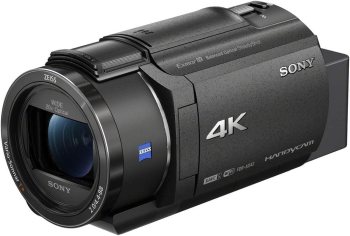- Excellent 4K UHD video quality
- Professional audio recording
- Effective image stabilization
- Ultra-smooth video stabilization
- High-quality 4K video
- Good audio recording
- High price point
- Complex for beginners
- Moderate learning curve
- Limited manual controls
Canon XA40 vs Sony FDR-AX43
The world of 4K camcorders has become increasingly competitive, with top brands like Canon and Sony vying for dominance. Two popular models that have garnered significant attention are the Canon XA40 and the Sony FDR-AX43. Both cameras boast impressive features, but they also have distinct differences that set them apart. In this comparison, we'll delve into the details of each camera to help you decide which one best suits your needs.
Image Quality
Both the Canon XA40 and Sony FDR-AX43 are capable of capturing stunning 4K footage at 30p, with a maximum resolution of 3840 x 2160 pixels. However, the Sony FDR-AX43 has a slight edge when it comes to image quality. Its 1/2.5-inch Exmor R CMOS sensor provides better low-light performance and a wider dynamic range, resulting in more vibrant and detailed footage. The Canon XA40, on the other hand, uses a 1/2.3-inch CMOS sensor, which still produces excellent images but may not quite match the Sony's level of quality.
Lens and Zoom
The Canon XA40 features a 20x optical zoom lens with a 35mm equivalent focal length of 29.3-601mm. This provides a versatile range for capturing both wide-angle shots and tight close-ups. The Sony FDR-AX43, however, boasts a 30x optical zoom lens with a 35mm equivalent focal length of 26.8-804mm. While the Sony's lens offers more reach, it's worth noting that the Canon's lens has a slightly wider angle of view, making it better suited for capturing expansive landscapes or interior shots.
Stabilization and Audio
Both cameras feature advanced image stabilization systems, with the Canon XA40 utilizing a 5-axis optical image stabilization system and the Sony FDR-AX43 employing a Balanced Optical SteadyShot (B.O.SS) system. The Sony's system is particularly effective at reducing camera shake and blur, making it ideal for handheld shooting or capturing smooth footage on the move.
In terms of audio, both cameras have built-in microphones, but the Canon XA40 has a slight advantage with its dual XLR inputs, allowing for more flexible audio recording options. The Sony FDR-AX43, however, features a built-in microphone with a wider frequency response range (50 Hz to 20 kHz), which provides clearer and more detailed sound.
Connectivity and Ergonomics
The Canon XA40 has a more comprehensive set of connectivity options, including HDMI, USB, and SDI outputs, as well as Wi-Fi and NFC for easy file transfer and remote control. The Sony FDR-AX43 also features Wi-Fi and NFC, but its HDMI output is limited to 4K at 30p, whereas the Canon XA40 can output 4K at 60p.
In terms of ergonomics, both cameras are designed with comfort and usability in mind. The Canon XA40 has a more compact body and a slightly lighter weight, making it easier to handle for extended periods. The Sony FDR-AX43, however, features a more intuitive control layout and a larger 3-inch LCD touchscreen, which provides a better viewing experience.
Conclusion
Both the Canon XA40 and Sony FDR-AX43 are excellent choices in the world of 4K camcorders. While the Sony FDR-AX43 has a slight edge in terms of image quality and lens reach, the Canon XA40 offers more flexible audio recording options and a more comprehensive set of connectivity features. Ultimately, the decision between these two cameras will depend on your specific needs and preferences.
If you prioritize image quality and a longer zoom range, the Sony FDR-AX43 may be the better choice. However, if you need a more compact camera with advanced audio capabilities and a wider range of connectivity options, the Canon XA40 is an excellent alternative. As the market for 4K camcorders continues to evolve, both of these cameras are sure to remain popular choices among videographers and content creators alike.


















